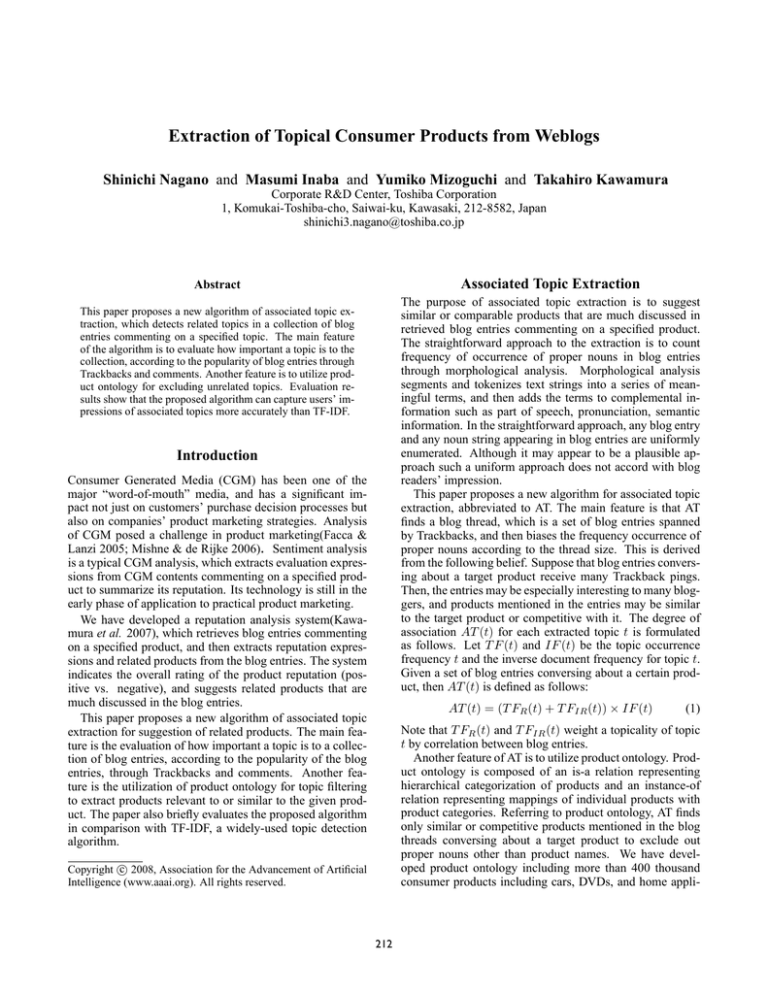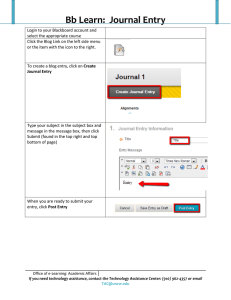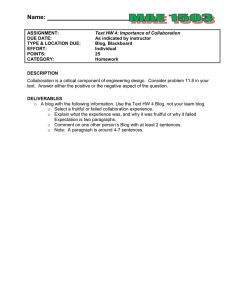
Extraction of Topical Consumer Products from Weblogs
Shinichi Nagano and Masumi Inaba and Yumiko Mizoguchi and Takahiro Kawamura
Corporate R&D Center, Toshiba Corporation
1, Komukai-Toshiba-cho, Saiwai-ku, Kawasaki, 212-8582, Japan
shinichi3.nagano@toshiba.co.jp
Associated Topic Extraction
Abstract
The purpose of associated topic extraction is to suggest
similar or comparable products that are much discussed in
retrieved blog entries commenting on a specified product.
The straightforward approach to the extraction is to count
frequency of occurrence of proper nouns in blog entries
through morphological analysis. Morphological analysis
segments and tokenizes text strings into a series of meaningful terms, and then adds the terms to complemental information such as part of speech, pronunciation, semantic
information. In the straightforward approach, any blog entry
and any noun string appearing in blog entries are uniformly
enumerated. Although it may appear to be a plausible approach such a uniform approach does not accord with blog
readers’ impression.
This paper proposes a new algorithm for associated topic
extraction, abbreviated to AT. The main feature is that AT
finds a blog thread, which is a set of blog entries spanned
by Trackbacks, and then biases the frequency occurrence of
proper nouns according to the thread size. This is derived
from the following belief. Suppose that blog entries conversing about a target product receive many Trackback pings.
Then, the entries may be especially interesting to many bloggers, and products mentioned in the entries may be similar
to the target product or competitive with it. The degree of
association AT (t) for each extracted topic t is formulated
as follows. Let T F (t) and IF (t) be the topic occurrence
frequency t and the inverse document frequency for topic t.
Given a set of blog entries conversing about a certain product, then AT (t) is defined as follows:
This paper proposes a new algorithm of associated topic extraction, which detects related topics in a collection of blog
entries commenting on a specified topic. The main feature
of the algorithm is to evaluate how important a topic is to the
collection, according to the popularity of blog entries through
Trackbacks and comments. Another feature is to utilize product ontology for excluding unrelated topics. Evaluation results show that the proposed algorithm can capture users’ impressions of associated topics more accurately than TF-IDF.
Introduction
Consumer Generated Media (CGM) has been one of the
major “word-of-mouth” media, and has a significant impact not just on customers’ purchase decision processes but
also on companies’ product marketing strategies. Analysis
of CGM posed a challenge in product marketing(Facca &
Lanzi 2005; Mishne & de Rijke 2006).Sentiment analysis
is a typical CGM analysis, which extracts evaluation expressions from CGM contents commenting on a specified product to summarize its reputation. Its technology is still in the
early phase of application to practical product marketing.
We have developed a reputation analysis system(Kawamura et al. 2007), which retrieves blog entries commenting
on a specified product, and then extracts reputation expressions and related products from the blog entries. The system
indicates the overall rating of the product reputation (positive vs. negative), and suggests related products that are
much discussed in the blog entries.
This paper proposes a new algorithm of associated topic
extraction for suggestion of related products. The main feature is the evaluation of how important a topic is to a collection of blog entries, according to the popularity of the blog
entries, through Trackbacks and comments. Another feature is the utilization of product ontology for topic filtering
to extract products relevant to or similar to the given product. The paper also briefly evaluates the proposed algorithm
in comparison with TF-IDF, a widely-used topic detection
algorithm.
AT (t) = (T FR (t) + T FIR (t)) × IF (t)
(1)
Note that T FR (t) and T FIR (t) weight a topicality of topic
t by correlation between blog entries.
Another feature of AT is to utilize product ontology. Product ontology is composed of an is-a relation representing
hierarchical categorization of products and an instance-of
relation representing mappings of individual products with
product categories. Referring to product ontology, AT finds
only similar or competitive products mentioned in the blog
threads conversing about a target product to exclude out
proper nouns other than product names. We have developed product ontology including more than 400 thousand
consumer products including cars, DVDs, and home appli-
c 2008, Association for the Advancement of Artificial
Copyright ⃝
Intelligence (www.aaai.org). All rights reserved.
212
Instance-of
Coupe
is-a
is-a
Model1
Sedan
Model2
Car
Table 1: Evaluation of precision and recall measures
Thread no.
(a) (b) Recall Precision
1
21 14 94.3%
100.0%
2 101 19 86.0%
97.6%
3
49 19 84.3%
100.0%
(a) Number of blog entries, (b) number of car models.
CarZ
Model3
SUV
Vehicle
CarA
CarB
Minivan
Motorcycle
Class
Table 2: Differences with the correct answer
Instance
Thread no. D1
D2 |D1-D2|
1 6.3 11.2
5.0
2 8.3 11.5
3.2
3 6.5
7.9
1.4
D1: Difference between AT and subjects’ answers
D2: Difference between TF-IDF and subjects’ answers
Figure 1: Product ontology
Subjects' answer
AT
TFIDF
100
80
60
and a product ontology. Thus, it is expected that experiments
in categories other than cars will produce different results of
performance evaluation.
The results of impression evaluation are shown in Figure
2. Scores of each method are normalized between 0 and
100. The results show that AT is more well-controlled and
closer to subjects’ impression than TF-IDF. For example, AT
gives considerably higher scores than TF-IDF to the cars that
subjects feel highly topical, as Car101 and Car108 shown
in Figure 2. The cars appear frequently in the blog entries
which receive a lot of Trackbacks and comments, and thus
AT raises a topicality of each car. Next, Table 2 shows the
difference between AT scores and subjects’ answers (D1)
and the difference between TF-IDF scores and subjects’ answers (D2). Note that both D1 and D2 are averaged per car.
Table 2 shows that AT is extremely closer to subjects’ impression than TF-IDF in all blog thread. As a result, we can
say that the proposed weighting formula accurately express
the strength of blog readers’ impression.
40
20
0
0
1
2
3
4
2
3
4
5
6
7
8
9
1
r10 ar10 ar10 ar10 ar10 ar10 ar10 ar10 ar10 ar11 ar11 ar11 ar11 ar11
C
C
C
C
C
C
C
C
C
C
C
C
C
Ca
Figure 2: Impression evaluation for blog thread 1
ances. A fragment of the product ontology is illustrated in
Fig.1.
Evaluation
Experiment is done as a part of feasibility studies for practical product marketing. We first prepare three blog thread
as collections, which comment on the same car in the sedan
category and include totally 171 blog entries. We then apply
AT to each collection and then evaluate the results of AT
with the two performance measures, recall and precision,
which are widely used in IR and NLP. In addition, we ask
18 trial subjects to extract topical cars from the collections
and to make their ratings in 4 levels as subjective impression.
We then compare the averages of the subjects’ answers with
the AT and TF-IDF scores.
The results of precision and recall evaluations are shown
in Table 1, where all precision scores are close to 100%.
One of the reasons why these extremely high scores are
achieved is that product ontology filtering functions effectively enough to exclude any noun other than product names.
Another reason is that very few blog entries in the collections comment on subjects other than car and thus the collections are easy to analyze. However, several terms are incorrectly extracted as product names, and thus reduce precision
scores. On the other hand, all recall scores are completely
over 80% as shown in Table 1, even though absence of some
car models from product ontology reduce recall scores. The
results of precision and recall measures depend on the maintenance status both of a morphological analysis dictionary
Conclusions
Refinement of the proposed algorithm is a future work to
gain higher qualities of extraction results. We are also planning to develop novel technologies for ontology building and
maintenance.
References
Facca, F., and Lanzi, P. 2005. Mining interesting knowledge from weblogs: a survey. Data and Knowledge Engineering 53(3):225–241.
Kawamura, T.; Nagano, S.; Inaba, M.; and Mizoguchi,
Y. 2007. Mobile service for reputation extraction from
weblogs - public experiment and evaluation. In Proceedings of Twenty-Second Conference on Artificial Intelligence (AAAI-07).
Mishne, G., and de Rijke, M. 2006. A study of blog search.
In Proceedings of 28th European Conference on Information Retrieval (ECIR).
213



